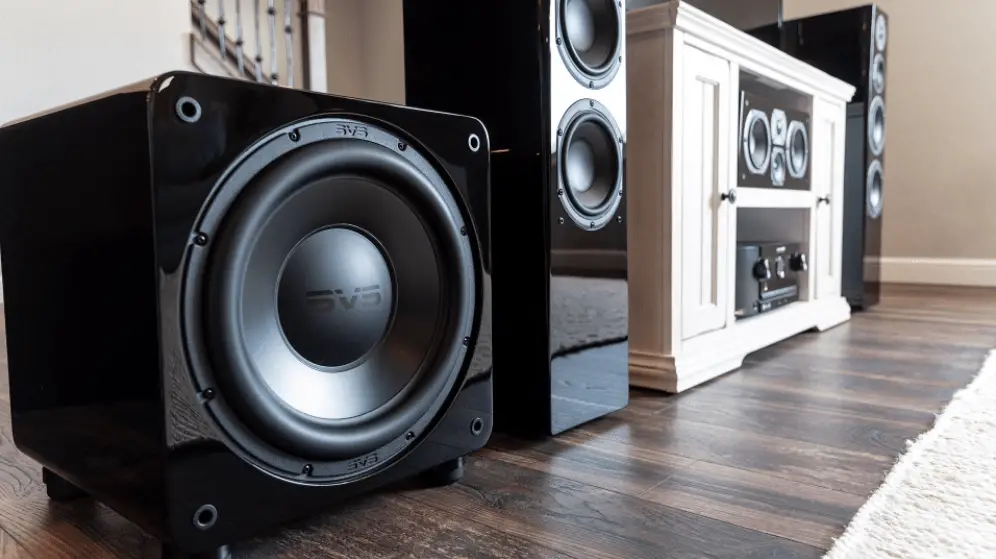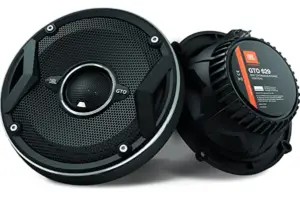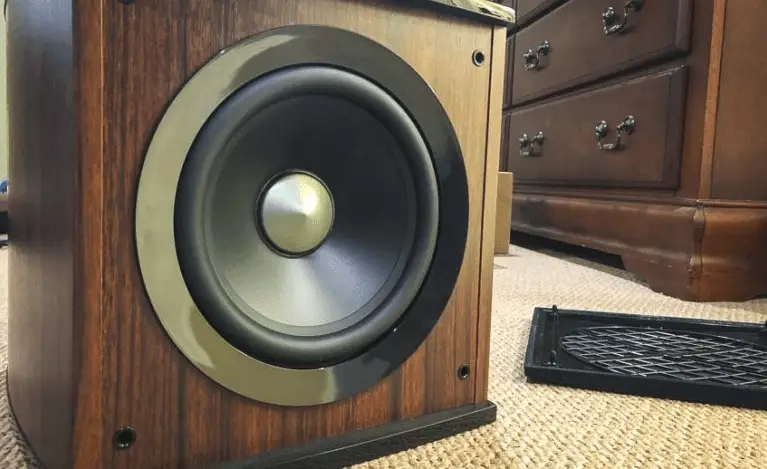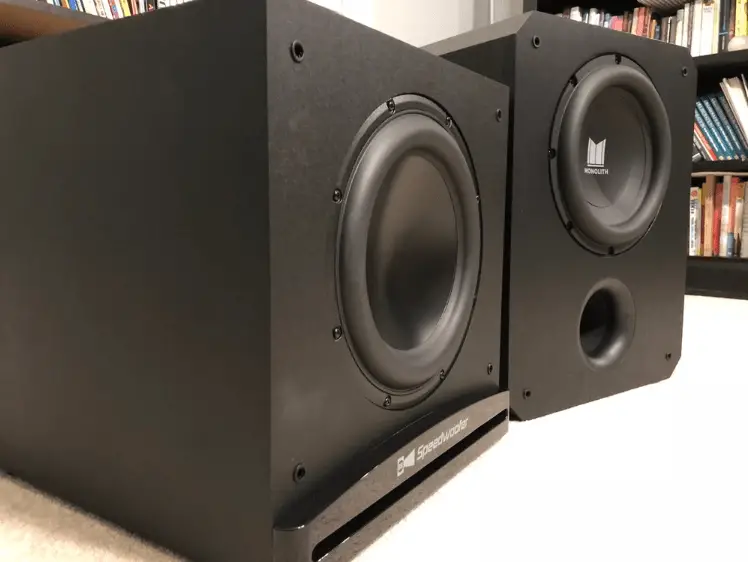The two most significant aspects of a subwoofer’s performance are low-frequency extension and sound pressure level (SPL).
The principles of physics state, that a big subwoofer may produce higher SPL and deeper bass than a smaller subwoofer.
An adequately designed big subwoofer has the ability to shake your legs and make it feel like the room is breathing with higher intensity.
But have you ever considered why this is the case? Why are most subwoofers so big and heavy?
Why Are Subwoofers So Big?
A big subwoofer will produce lower bass than a smaller subwoofer, but you will lose a lot of bass tightness.
A big subwoofer will have less overall output, but it will have higher power at lower frequencies because of its improved low-frequency extension. However, if you go too big, you’ll lose overall output as well as low-frequency output (extension).
All of the explanation is based on the movement of air. A sub has to move a lot of air to generate the huge booming noise, and the surface area of the driver affects this. The more surface area there is, the more air it can move.
The size of the speaker matters a lot when it comes to subwoofers! If you buy a subwoofer that only has a couple of 8-inch drivers inside a box, you will be very unhappy with the outcome. With low-frequency sounds, there won’t be as much power.
In essence, bigger is always better as long as the frequency of the sub isn’t expected to go too high.
Why Do Big Subwoofers Produce Better Sound?
Because of their small size, small subwoofers cannot provide a clear sound in all situations. It restricts the amount of power they can generate. These subwoofers struggle with huge sounds, like explosions in a movie, as well as sounds with too low a pitch.
Smaller subwoofers are often capable of producing mid to high pitch noises. However, when a small subwoofer attempts to produce very low-frequency noises, the sound suffers from significant distortion.
On the other hand, big subwoofers are designed to produce large, loud noises. Big subwoofers enable larger speakers to have better frequency responses than smaller subwoofers.
The frequency response of a subwoofer is the range of bass, mids, and treble that it can produce without distortion.
There are fewer strained sounds with big subwoofers. Small subwoofers produce the illusion of complete sound, whereas big subwoofers deliver it in reality. The sounds are complete, genuine, and authentic.
Subwoofers are designed to reproduce low-frequency sounds and Music definitely sounds better when you listen to it through big subwoofers.
Remember that a large subwoofer provides you with everything you require in a single piece of equipment. A big subwoofer is not dependent on anything other than itself (and your ability to set it up properly).
Does The Size of The Subwoofer Matter?
When it comes to subwoofers, the answer is definitely yes, and size is quite important. Big subwoofers have a better sound and can play louder, but they take up a lot of space.
If you have a couple of 10-inch drivers in a box that you call a subwoofer, you’ll be dissatisfied if you follow the setup instructions because you won’t get the same results. Big subwoofers are great as long as you don’t ask them to go in high frequency.
Surface area is important for moving air and achieving low frequencies. The lowest notes on a pipe organ, Imperial Grand Piano, and tuba are around 16Hz – a frequency considered below the human hearing.
These instruments do not produce single notes at this frequency, but they produce many higher frequency harmonics. The harmonics that give the instrument its sound character.
And those higher frequencies, combined with the low fundamental, give the note a complete emotional sense. When played live, any of these instruments will produce a sound that you can feel as well as hear.
So, using a big subwoofer to play the sound of these instruments will help you in achieving the low frequencies produced by them.
Also Read: How Can I Make My Subwoofer Waterproof?
Amplitude Of A Subwoofer
Bass drivers are widely recognized as large, but low-frequency drivers are typically small.
When it comes to the energy that waves convey, a high-frequency wave contains more energy and only takes a small amount of amplitude to carry more energy.
Low-frequency waves, on the other hand, are not very energetic and so require a relatively large amplitude to take the same amount of energy.
So, in order for the speaker to be loud, you must combine a large amount of low-frequency amplitude with a small amount of high-frequency amplitude.
This means that high-frequency drivers don’t have to displace a lot of air to generate increased pressure, allowing them to be tiny in size.
Furthermore, high frequencies require very fast motion. Therefore the driver must be light in mass. It would be impractical for anything as enormous and big as a woofer to move back and forth at that rate.
To make your bass even louder, you must move a lot of air. However, if you’re only looking for a tiny amount of bass, the driver shouldn’t be too big. An excellent example is headphones, which provide just enough bass to make listening enjoyable.
Another thing to remember is that a large driver isn’t necessarily required to move a lot of air. This is feasible if you have a little driver with a lot of excursions. The main issue is that it is logistically tough to achieve, so big subs and woofers are commonly used.
Are Subwoofers Usually Big?
Both yes and no. The classic image of a subwoofer is a big enclosure with a single massive speaker.
These are still popular and frequently the best options, but many people dislike the idea of wanting to cover something so big in their room.
Newer technology, more efficient amplifiers, and dual-driver designs have significantly reduced the footprint of some subwoofers, allowing them to be readily hidden in a room.
The trick is to ensure that the subwoofer’s amplifier is powerful enough to power the driver properly and that the subwoofer’s range mixes well with your primary speakers.
Big Subwoofer Driver
Low power extension and sound pressure level (SPL) are typically regarded as the two most essential performance criteria for a subwoofer.
According to the rules of physics, a big subwoofer driver has the capacity to create higher SPL and deeper bass relative to a smaller subwoofer driver.
However, SPL and low-frequency extension aren’t the only relevant performance measures, and not all big subwoofer drivers perform equally well.
Accuracy, transient speed, and the ability to blend seamlessly with full-range speakers are all important factors when judging the effectiveness of any sized subwoofer, and a subwoofer driver is only as good as the motor and amplifier powering it, so a bigger driver doesn’t always mean better performance.
Comparison Between Big And Small Subwoofers? Which One Is Better?
To have a better understanding of sound quality and why a big subwoofer isn’t always better than a small subwoofer, let’s look at the three significant components of subwoofer performance:
Low-Frequency Extension
Even at maximum volume, Many subwoofers lack the ability to reproduce the deepest bass frequencies and attempt to compensate by distorting the mid-bass frequencies.
On the other hand, A genuinely big subwoofer, will create all of the low frequencies, including those that are too low to listen (and can only be felt), and it will be able to do so even at maximum volume.
Low-quality subwoofers limit the volume output of their amplifiers, causing the bass to “disappear” once the volume exceeds the conversation level.
Accurate Source Content Delivery
If you’re at a live event, music and sound will pass through several filters between the source the instrument making the sound – and the target like your ear.
On this journey, sound may be lessened, boosted, manipulated, tweaked, or otherwise altered in a way that detracts from the experience intended by the performers and music producer.
Even an inexperienced ear can distinguish between boomy “one-note” bass and a complete bass sound that vibrates inside your chest cavity.
An excellent subwoofer, big or little, adds no audible signature and is totally true to the source content, including starts and stops or “transients.”
Seamless Blending
Subwoofers should blend in with the other full-range speakers in your system, including satellite and tower speakers, rather than drawing emphasis to the bass alone.
Why Are Subwoofers So Expensive, Big, And Heavy?
Whenever it comes to weight, the large size of the subwoofer has a direct impact. In addition to the large driver, more stuff is used to construct the surround, resulting in a heavier unit when compared to the speakers of low frequencies.
Meanwhile, the subwoofer’s high price is due to the niche business of sound devices. The problem is that only a small percentage of the population wants this sort of equipment, making it difficult for sound producers to recoup the cost of R&D.
Furthermore, subwoofers are usually overpriced because the technology that powers them slowly moves, and the device is also very long-lasting.
As a result, they don’t sell as quickly as products like flat-screen TVs, which see significant improvements with each passing year.
To summarize, subwoofers necessitate a large profit margin in order for the company to be profitable! Size (more items utilized), warranty, and shipping are also factors that raise the cost of subwoofers.
Identifying The Ideal Big Subwoofer?
Driver size and low-frequency extension are all important considerations when selecting a big or small subwoofer.
Understanding the benefits and drawbacks of big subwoofer drivers, the technology behind them, and what to look for when exploring big subwoofers will always help you in your quest for the ideal bass experience.
The Benefits and Drawbacks of Big Subwoofers
When selecting a subwoofer, size isn’t necessarily an issue. The best models feature a powerful enough motor to generate force.
If you come across something large that lacks these characteristics, you may notice that some bigger ones sound worse than the smaller ones.
When looking for subwoofers with large drivers, it is essential to consider the rules of physics.
If the motor can’t keep up with the rest of the unit, you will have something resembling a paperweight for your sound system.
When you have a subwoofer with a big driver and a small motor in your car, it may sound worse than the default stereo system!
That is why a review of the benefits and drawbacks of big subwoofers can point you in the right direction. Here are the benefits and drawbacks you should think about today.
Pros of Big Subwoofers
- Most large subwoofers do not produce phase shifts at the XO point, ensuring that what you hear is harmonically true.
- It has a higher sensitivity rate than smaller models or multi-driver configurations.
- You get a kick in the pants from the bass, pushing you to pay attention to the music.
- It exudes an enthusiasm that is impossible to ignore when playing practically anything.
- A larger subwoofer produces lower frequencies, allowing you to feel the bass deep in your intestines.
- With the largest drivers, you’ll get more sound amplification and reach, allowing listeners in the back of the room to have a pleasant experience.
Cons of Big Subwoofers
- With a single big subwoofer driver, you can just focus on the specific frequency bands.
- If your subwoofer arrangement includes a multi-driver option or numerous units, you might have each one focus on a different frequency band.
- A single driver will always give a narrower frequency range to the subwoofer than other designs, limiting the useful range of your device.
- When playing audio, larger subwoofers often lack balance and sound definition.
- Larger subwoofers add weight. A cabinet-mounted 18-inch subwoofer might weigh more than 200 pounds.
Frequently Asked Questions
Is It True That Big Subwoofers Sound Better?
The two most significant aspects of a subwoofer’s performance are low-frequency extension and sound pressure level (SPL). According to physics principles, a big subwoofer driver may produce higher SPL and deeper bass than a smaller subwoofer driver.
Is It Possible For A Tweeter To Produce Low-Frequency Sound?
Yes! You can easily produce a 20Hz tone with a tweeter. The same would be true if you have a set of headphones along with drivers the size of a 1″ tweeter.
You won’t be able to hear the tone from the tweeter or headphones because the amplitude is simply too small and the tweeter isn’t developed to get the excursion needed to transfer that much air.
Do Bigger Subwoofers Have A Stronger Punch?
Most subs require a certain level of back pressure to function properly. A box that is too large enables the driver to increase the mechanical limitations of the vehicle. It is simply not wise to do so, regardless of whether you think it sounds “audible” or “superior.”
Is A Larger Subwoofer More Powerful?
When comparing 10s and 12s, Smaller subwoofers are slightly more accurate in real-world applications, while larger subwoofers are slightly louder.
Is A 15-Inch Subwoofer Excessively Big?
The truth is that better is a matter of personal preference. if we compare a 15-inch and 12-inch subwoofer than , Because 15-inch subwoofers are bigger and expel more air than 12-inch subwoofers, they will e heavy and sound louder than the 12-inch sub.
On the other hand, the 12-inch subwoofer will have a noticeably sharper, crisper sound than the bigger sizes.
Final Thought
So, if you’ve ever questioned why all the subwoofers you see while Buying seem to be so big, the above post provides a good explanation.
When seeking the loudest boom in a sub, remember that big is preferable. However, keep in mind the amount of space you have.






